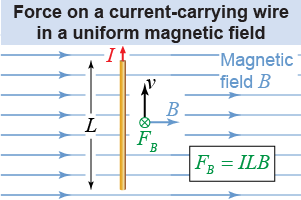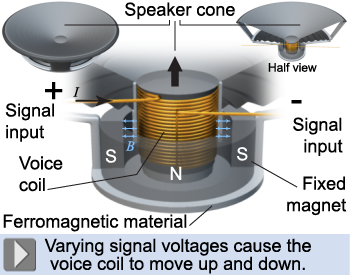|
Inside a current-carrying wire, charged particles (electrons!) are moving. When one such wire is near another, each wire creates a magnetic field that exerts a magnetic force on the moving charges in the other wire. What happens? 
|

|
The direction of the magnetic force on either wire depends on the direction current is flowing in both. If the current in the two wires is in the same direction, then applying the right-hand rule shows that the magnetic force attracts the two wires to each other, as shown in the illustration above. If the currents are in opposite directions, then the magnetic force causes the wires to repel each other. 
|
 The top illustration depicts the direction of the magnetic force on each wire that is in a magnetic field, as determined by using the right-hand rule. But what is the magnitude of the force? Intuitively, we should expect the magnetic force to be stronger if the length of the wire is longer, or if the current flowing through it is larger, or if the magnetic field around it is stronger—which is the relationship in equation (19.7)!
The top illustration depicts the direction of the magnetic force on each wire that is in a magnetic field, as determined by using the right-hand rule. But what is the magnitude of the force? Intuitively, we should expect the magnetic force to be stronger if the length of the wire is longer, or if the current flowing through it is larger, or if the magnetic field around it is stronger—which is the relationship in equation (19.7)! 
|
| (19.7) | | | FB | = | magnetic force (N) | | I | = | current (A) | | L | = | length of wire (m) | | B | = | magnetic field (T) |
| Magnetic force
on a current-carrying wire |
|
 The operation of the loudspeaker uses the magnetic force on a current-carrying wire (the voice coil) in a fixed magnetic field. As the signal current through the coil varies, the resulting force on the voice coil moves it up and down. The direction of current in the illustration causes the speaker cone to move upward; when the current reverses, the cone moves downward. The voice coil is attached to a speaker cone, which is often made of foam. When the cone moves up and down, it creates pressure waves—or sound!—in the air.
The operation of the loudspeaker uses the magnetic force on a current-carrying wire (the voice coil) in a fixed magnetic field. As the signal current through the coil varies, the resulting force on the voice coil moves it up and down. The direction of current in the illustration causes the speaker cone to move upward; when the current reverses, the cone moves downward. The voice coil is attached to a speaker cone, which is often made of foam. When the cone moves up and down, it creates pressure waves—or sound!—in the air. 
 |
The moving-coil microphone works using magnetic induction, exactly the same as a loudspeaker—just in reverse! Pressure waves of sound enter the microphone and cause the diaphragm to vibrate. This causes oscillations of a coil that is wrapped around the diaphragm and located within a fixed magnetic field. The oscillations generate varying electric current within the coil, which is the electrical signal representing the original sound. 
|
One wire is located in the plane of the page and carries current in the positive x-direction. A second wire is located slightly above it (but parallel to the plane of the page) and carries current in the positive y-direction. What is the direction of the magnetic force on each wire?
 |
There is no force on either wire! The magnetic field created by one wire is parallel to the direction of current flowing in the other wire. As a result, the angle between the velocity of the moving charges and the magnetic field is θ = 0°. From equation (19.4), the magnetic force is therefore zero! 
|

